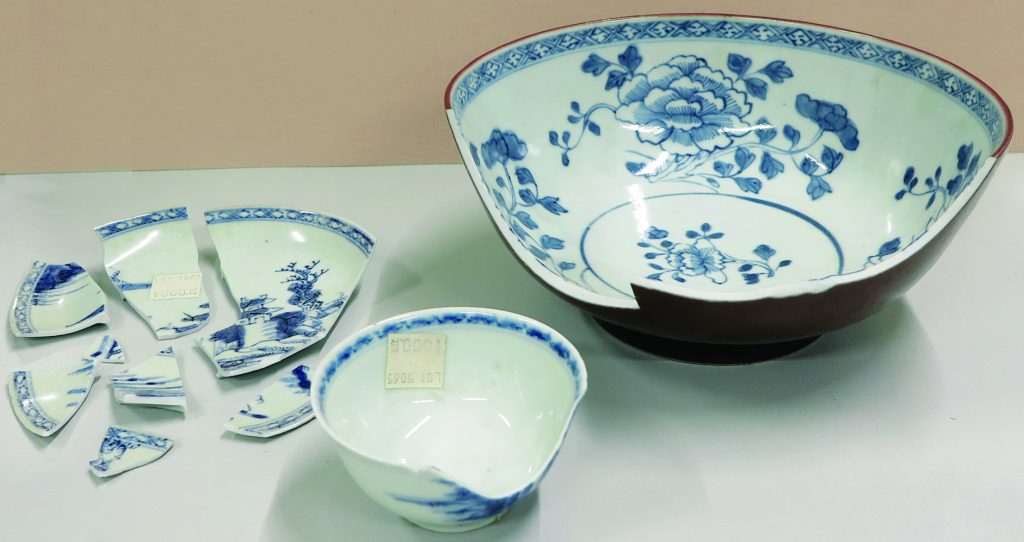In 1752 a ship with a cargo of spices, silks and ceramics sank in the South China Sea. A treasure rediscovered centuries later and a fragment of which has reached PIME
On January 3, 1752, a ship of the Dutch East India Company, the Geldermalsen, sank in the South China Sea after hitting a rock. About 80 people died in the shipwreck and an enormous quantity of Chinese objects sank: tea, spices, furniture, lacquerware, porcelain, fabrics, silks, all directed to the western market.
These events are just the beginning of a long story, which began in China 270 years ago and reached the PIME today. To tell us about it are three Chinese porcelains, a saucer and two bowls, partly broken, that we found in the deposit of the Museo Popoli e Culture during the inventory work that will lead us to examine around 3,000 objects. An adventurous story that talks about a long journey, different cultures and encounters, pieces that a brief note, two stickers and some initial research have allowed us to piece together.
The Geldermalsen had been loaded with about 150,000 porcelains, made in the kilns of Jingdezhen, in southern China: an ancient center of ceramic production, known during the Ming dynasty (1368-1644) for the refined imperial porcelains and during the Qing dynasty (1644 -1911) for the pieces destined for export, characterized by greater sturdiness and by appreciated decorations in cobalt blue and green and pink enamels. This rather remote locality possessed three characteristics that made it particularly suitable for becoming a thriving industry: it was located on land rich in petuncios, the basic material together with kaolin for the porcelain paste, it had a large availability of trees necessary to heat the furnaces and had a river, a fundamental way for the transport of delicate objects.
Until the early 1700s porcelain was not made in Europe but much admired. Even after internal production began, large quantities continued to be imported from China to satisfy the numerous requests: to this end, Chinese craftsmen began to create pieces characterized by shapes, decorations and uses unknown to them but capable of meeting Western tastes. This is the so-called “Chine de commande”, which will enrich the equipment and homes of European families from the eighteenth century up to the end of the nineteenth century and the first part of the twentieth century.
The Geldermalsen therefore set sail in December 1751 directed towards Holland and loaded with precious porcelain and other materials destined for Europe, but sank after only 16 days of navigation. For two centuries the silence and the sea guarded her treasure, until in 1985 Captain Michael Hatcher, an English explorer particularly active in the search for sunken treasures, identified the ship with her immense load. The discovery made headlines and attracted the attention of collectors and auction houses: in the spring of 1986 all of Geldermalsen’s cargo, under the name of Nanking cargo, was purchased and auctioned in Amsterdam at Christie’s. From Europe to Italy the step was shorter: three porcelains were purchased from an antique dealer in Milan who then generously donated them to the PIME museum.
On the bottom of these objects there is still the sticker from the Christie’s auction with the assigned lot number and the plate of the Milanese shop that bought and donated them, the “Perotto antiquity”, the last two pieces of their long history. The time spent at sea and the shipwreck are visible in the fragments to which the saucer is reduced and in the chipping on the edges of the two bowls. Of the 150,000 porcelains loaded on the ship, many others managed to remain intact, because they were packed together with the packets of tea which cushioned the shocks and effects of the sea salt.
The three pieces donated to the PIME Museum are porcelains with white ceramic paste and blue decorations made from cobalt, which depict a landscape scene, barely visible on the shards of the saucer and on the smaller bowl, and floral compositions of peonies and chrysanthemums well visible on the larger bowl, which also has a brown and homogeneous external color called Batavia, from the name of the commercial center founded in the seventeenth century by the Dutch East India Company and corresponding more or less to the current Jakarta. The preciousness of these objects does not lie so much in their commercial value, partly reduced by the fact of being broken, but in the rich history of which they are part and of which they offer a testimony, survived through time and events thanks to the care of those who he donated and kept them. They are part of the large group of Chinese objects kept in the deposit of the Peoples and Cultures Museum, which we are inventorying as the Cultural Heritage Office: they are ornaments, fabrics, ritual pieces and pieces linked to popular religiosity, coins, objects of art and daily use, geographical maps, lacquered cabinets.
Small discoveries or rediscoveries that re-emerge after having dusted them off and taken up the ranks of notes, scrolls and index cards. An exciting challenge that allows us to reconstruct not only a distant world but also the history of the people who created these objects and of the missionaries who brought them to PIME to speak with love and admiration of the cultures and peoples encountered.
A path that starts from the past but always looks to the future, with the commitment of the Museum and the Cultural Heritage Office for the conservation and enhancement of its heritage, in favor of the memory of the Institute and for the benefit of all those who want to enjoy it .
